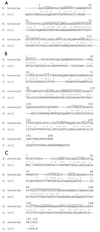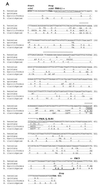Molecular analysis of riboflavin synthesis genes in Bartonella henselae and use of the ribC gene for differentiation of Bartonella species by PCR
- PMID: 10488170
- PMCID: PMC85516
- DOI: 10.1128/JCM.37.10.3159-3166.1999
Molecular analysis of riboflavin synthesis genes in Bartonella henselae and use of the ribC gene for differentiation of Bartonella species by PCR
Abstract
The biosynthesis pathway for riboflavin (vitamin B(2)), the precursor of the essential cofactors flavin mononucleotide and flavin adenine dinucleotide, is present in bacteria and plants but is absent in vertebrates. Due to their conservation in bacterial species and their absence in humans, the riboflavin synthesis genes should be well suited either for detection of bacterial DNA in human specimens or for the differentiation of pathogenic bacteria by molecular techniques. A DNA fragment carrying the genes ribD, ribC, and ribE, which encode homologues of riboflavin deaminase (RibD) and subunits of riboflavin synthetase (RibC and RibE), respectively, was isolated from a plasmid-based DNA library of the human pathogen Bartonella henselae by complementation of a ribC mutation in Escherichia coli. Sequence analysis of the ribC gene region in strains of B. henselae, which were previously shown to be genetically different, revealed that the ribC gene is highly conserved at the species level. PCR amplification with primers derived from the ribC locus of B. henselae was used to isolate the corresponding DNA regions in B. bacilliformis, B. clarridgeiae, and B. quintana. Sequence analysis indicated that the riboflavin synthesis genes are conserved and show the same operon-like genetic organization in all four Bartonella species. Primer oligonucleotides designed on the basis of localized differences within the ribC DNA region were successfully used to develop species-specific PCR assays for the differentiation of B. henselae, B. clarridgeiae, B. quintana, and B. bacilliformis. The results obtained indicate that the riboflavin synthesis genes are excellent targets for PCR-directed differentiation of these emerging pathogens. The PCR assays developed should increase our diagnostic potential to differentiate Bartonella species, especially B. henselae and the newly recognized species B. clarridgeiae.
Figures






Similar articles
-
Detection and identification of Bartonella species pathogenic for humans by PCR amplification targeting the riboflavin synthase gene (ribC).J Clin Microbiol. 2003 Mar;41(3):1069-72. doi: 10.1128/JCM.41.3.1069-1072.2003. J Clin Microbiol. 2003. PMID: 12624031 Free PMC article.
-
Bartonella koehlerae, a new cat-associated agent of culture-negative human endocarditis.J Clin Microbiol. 2004 Aug;42(8):3462-8. doi: 10.1128/JCM.42.8.3462-3468.2004. J Clin Microbiol. 2004. PMID: 15297484 Free PMC article.
-
Use of the cell division protein FtsZ as a means of differentiating among Bartonella species.Clin Diagn Lab Immunol. 1998 Nov;5(6):766-72. doi: 10.1128/CDLI.5.6.766-772.1998. Clin Diagn Lab Immunol. 1998. PMID: 9801332 Free PMC article.
-
Bartonella spp. Infections Identified by Molecular Methods, United States.Emerg Infect Dis. 2023 Mar;29(3):467-476. doi: 10.3201/eid2903.221223. Emerg Infect Dis. 2023. PMID: 36823096 Free PMC article. Review.
-
Bacillary angiomatosis in immunocompromised patients.AIDS. 1998 Oct 1;12(14):1793-803. doi: 10.1097/00002030-199814000-00011. AIDS. 1998. PMID: 9792380 Review.
Cited by
-
Molecular evidence of Bartonella DNA in ixodid ticks in Czechia.Folia Microbiol (Praha). 2007;52(5):503-9. doi: 10.1007/BF02932111. Folia Microbiol (Praha). 2007. PMID: 18298048
-
Under-diagnosis of vector-borne diseases among individuals suspected of having Scrub Typhus in South Korea.PLoS One. 2023 Jun 2;18(6):e0286631. doi: 10.1371/journal.pone.0286631. eCollection 2023. PLoS One. 2023. PMID: 37267407 Free PMC article.
-
Molecular and functional characterization of riboflavin specific transport system in rat brain capillary endothelial cells.Brain Res. 2012 Aug 15;1468:1-10. doi: 10.1016/j.brainres.2012.05.052. Epub 2012 Jun 7. Brain Res. 2012. PMID: 22683359 Free PMC article.
-
16S/23S rRNA intergenic spacer regions for phylogenetic analysis, identification, and subtyping of Bartonella species.J Clin Microbiol. 2001 Aug;39(8):2768-78. doi: 10.1128/JCM.39.8.2768-2778.2001. J Clin Microbiol. 2001. PMID: 11473990 Free PMC article.
-
Opportunities for Riboswitch Inhibition by Targeting Co-Transcriptional RNA Folding Events.Int J Mol Sci. 2024 Sep 29;25(19):10495. doi: 10.3390/ijms251910495. Int J Mol Sci. 2024. PMID: 39408823 Free PMC article. Review.
References
-
- Bacher A, Eberhardt S, Richter G. Biosynthesis of riboflavin. In: Neidhardt F C, Curtiss III R, Ingraham J L, Lin E C C, Low K B, Magasanik B, Reznikoff W S, Riley M, Schaechter M, Umbarger H E, editors. Escherichia coli and Salmonella: cellular and molecular biology. Washington, D.C: American Society for Microbiology; 1996. pp. 657–664.
-
- Bereswill S, Fassbinder F, Voelzing C, Covacci A, Haas R, Kist M. Hemolytic properties and riboflavin synthesis of Helicobacter pylori: cloning and functional characterization of the ribA gene encoding GTP-cyclohydrolase II that confers hemolytic activity to Escherichia coli. Med Microbiol Immunol. 1998;186:177–187. - PubMed
MeSH terms
Substances
Associated data
- Actions
- Actions
- Actions
- Actions
LinkOut - more resources
Full Text Sources
Other Literature Sources
Molecular Biology Databases

